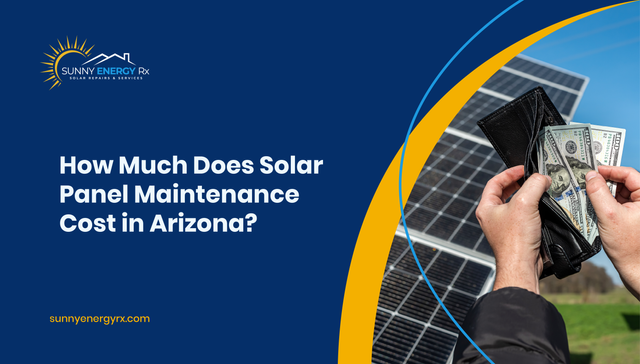Arizona Solar Maintenance: Budget Smart, Service Right (2025 Edition)
This blog was originally published on Sunny Energy RX.
Owning solar in Arizona means top-tier sunshine and a climate that steadily adds wear. Dust films the glass between rains, triple-digit heat accelerates electronic aging, and monsoon bursts tuck debris where you can’t see it. When you plan maintenance, think in terms of protecting output, safeguarding your roof, and avoiding surprise repairs. A clear budget comes from understanding what you’ll do routinely, what varies with your home, and what to expect in the occasional “project” year.
Start with outcomes, not line items
The financial win isn’t a brief sparkle after a rinse, it’s consistent production supported by safe wiring and tight roof penetrations. That outcome comes from pairing cleaning with inspection, diagnostics, and simple proof of work you can keep on file. When each visit ends with photos and a readable summary, next year’s budget becomes predictable.
Your recurring costs: the core bundle
Most Arizona homeowners plan for a once-or-twice-yearly bundle that includes:
- Residue-free cleaning to remove light-scattering dust without mineral spots.
- System inspection covering racking torque and alignment, flashing and sealants at penetrations, wiring and junctions, grounding continuity, and an electronics check of inverter/optimizer logs and communications.
- Performance verification comparing actual output with seasonal expectations, plus a short report with photos.
This bundle is the baseline that preserves yield in our dust, heat, and storm cycle.
Variables that swing the price
Two homes on the same street can see different quotes because time on site, not panel count alone, drives cost. Expect variation from:
- Access and layout: roof height, pitch, and multiple roof planes.
- Micro-climate: proximity to agriculture, construction, highways, or wind corridors that increase soiling.
- Equipment mix: diagnosing a single string inverter vs. dozens of microinverters.
- Age and condition: older arrays need more preventive touchups.
- Warranty coverage: can convert a replacement into a routine service call.
Cadence planner: choose a lane
Pick a rhythm that fits where you live and how old your system is.
- Annual comprehensive (most homes): reset cleanliness, verify hardware, review logs, and assess year-over-year performance.
- Semiannual (dust corridors or older arrays): add a lighter mid-year service to catch wear before peak heat.
- Event-based touchups: after strong winds or monsoon bursts, schedule only when monitoring shows an unexplained dip on otherwise clear days.
You’re aiming for fewer emergencies, not more appointments.
What a professional visit should deliver (quick checklist)
- Residue-free wash that protects coatings and avoids mineral spotting.
- Mechanical verification: racking torque, alignment, flashing and sealant health.
- Electrical checks: wiring, junctions, grounding continuity; scan for heat stress and corrosion.
- Electronics review: inverter and optimizer error logs, communications uptime, firmware status.
- Production validation against seasonal expectations, with photos and a plain-language summary.
If these steps are standard, the budget stays steady and issues stay small.
Estimate templates you can actually use
Every roof is unique, but these ranges keep planning realistic:
- Lean year: One thorough cleaning and annual inspection on a newer, easy-access system; minimal corrective work.
- Typical year: One to two cleanings, the annual comprehensive check, and a couple of minor fixes (reseating a connector, resealing a conduit cap).
- Project year: Removal and re-install for roofing, critter-guard installation where nesting occurs, or attention to aging electronics. Spend spikes once, then normalizes.
Keep each visit’s photos and notes, because last year’s evidence is the best predictor of next year’s spend.
Ways to keep totals in check (without cutting corners)
- Bundle visits so cleaning and inspection happen together.
- Use monitoring trends to time service before small issues grow.
- Mind water quality on any gentle DIY rinse for ground-mounts; avoid untreated hard water and high pressure.
- Prevent the preventable: critter guards in active areas, tidy cable management on older arrays, clear drainage at roof planes.
- Trim branches early to stop new shade from sapping output.
Bottom line
In Arizona, maintenance is yield protection. Cleaning alone won’t deliver it; the value lies in disciplined inspection, data-backed verification, and a cadence tuned to desert realities. Build your plan around access, micro-climate, and equipment mix, and revisit it annually using the photo reports you’ve collected.
For the full walkthrough with scenario examples and deeper ranges, continue with the detailed guide on Sunny Energy RX.
